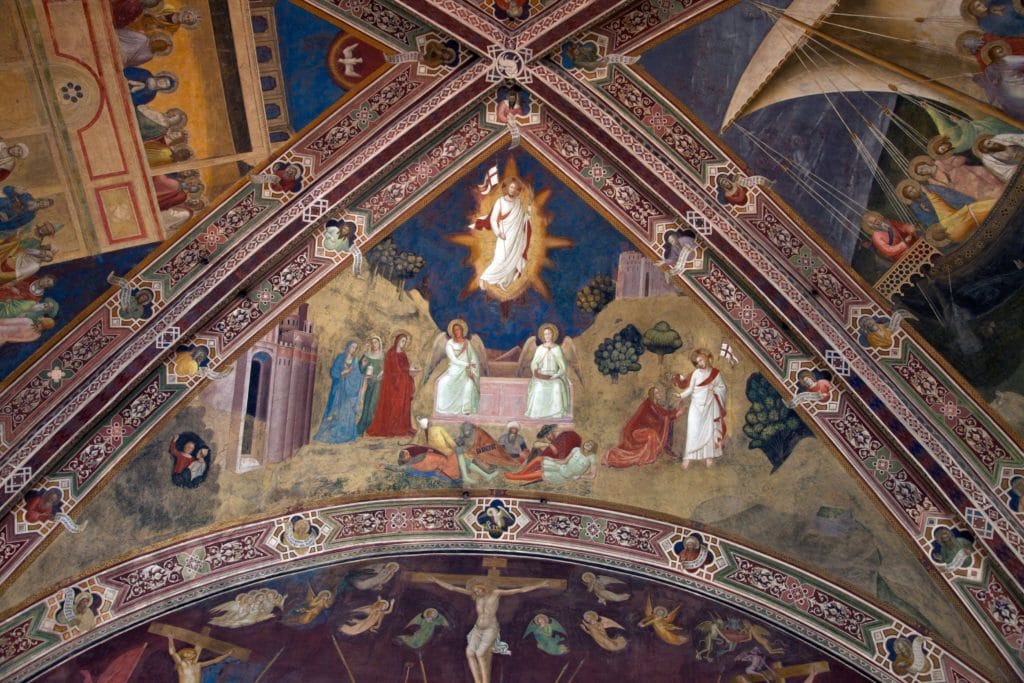
Jesus’ Resurrection
The Death of Death
Sunday, April 21, 2019
Easter
The seeds of Easter are already found in Christmas. If God can become flesh, incarnating in the material world, then resurrection is a natural conclusion. Nothing divine can die. Easter isn’t celebrating a one-time miracle as if it only happened in the body of Jesus and we’re all here to cheer for Jesus. That’s really not the point, but it is the message most Western Christians have been told. When Christianity split into East and West in 1054, both sides lost a piece of the puzzle.

The Eastern Church saw the resurrection in at least three ways: the trampling of hell, the corporate leading out of hell, and the corporate uplifting of humanity with Christ. [2] In Eastern icons of the resurrection, sometimes called “The Harrowing of Hell,” Jesus is surrounded by many people as he stands astride the pit of hell (as shown by this week’s banner from a medieval Byzantine church in Istanbul). [3] There are chains, bolts, and locks flying in all directions. In many interpretations, Hades—the god of death, not to be confused with Satan—is bound at the bottom of the pit, while Jesus pulls Adam and Eve, symbols of all humanity, out of hell. This is a very different message that never made it to the Western Church, either Catholic or Protestant. Eastern imagery suggests a hopeful message that is not only about Jesus but about society, humanity, and history itself.
Brothers and sisters, if we don’t believe that every crucifixion—war, poverty, torture, hunger—can somehow be redeemed, who of us would not be angry, cynical, hopeless? No wonder Western culture seems so skeptical today. It all doesn’t mean anything, it’s not going anywhere, because we weren’t given a wider and cosmic vision of Jesus’ resurrection. Easter is not just the final chapter of Jesus’ life, but the final chapter of history. Death does not have the last word.
Christ is not just pulling Adam and Eve out of hell. He’s pulling creation out of hell. Christ destroys death. We sing that in our songs and read it in our Scriptures (1 Corinthians 15), but for many Christians it seems to be “pretend.” For most of the past 2,000 years, the West tended to threaten us with death and hell: “If you don’t do it right, you’re going to hell.” Within many Eastern Orthodox churches, we see Jesus literally pulling people out of hell. Christ is the overcoming of hell and death in a very real, promised way. That’s what we’re celebrating today. You might consider joining an Orthodox service next Sunday, April 28, the day the Orthodox church observes Easter, and experience their excitement. Human beings do not tend to get deeply excited about things unless we are somehow a part of it.
References:
[1] The Resurrection, Andrea di Bonaiuto, 1365-1367, Spanish Chapel, Basilica of Santa Maria Novella, Florence, Italy, Peter Barritt / Alamy Stock Photo.
[2] See John Dominic Crossan and Sarah Sexton Crossan, Resurrecting Easter: How the West Lost and the East Kept the Original Easter Vision (HarperOne: 2018), 153-154.
[3] The Resurrection, 1316-1321, The Church of Holy Savior in Chora, Istanbul, Turkey, Chora Museum, Ayhan Altun / Alamy Stock Photo.
Adapted from Richard Rohr, Homily: “The Eastern Church Gets It More than the Western Church,” April 1, 2018; and
The Universal Christ: How a Forgotten Reality Can Change Everything We See, Hope For, and Believe (Convergent: 2019), 105.

